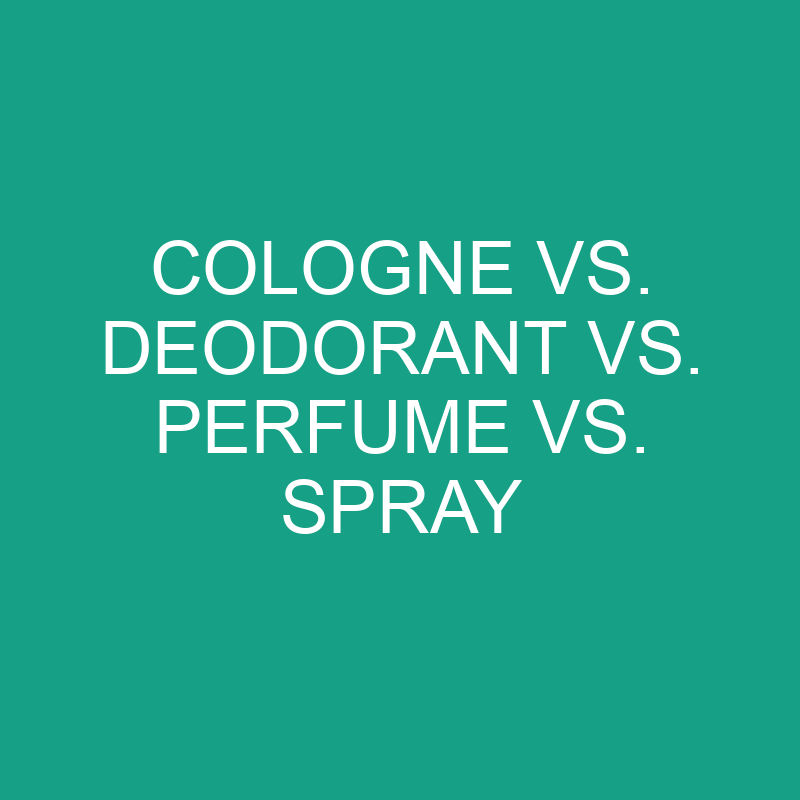Decoding Scents
In the world of personal grooming and fragrance, the array of products can be overwhelming. From colognes to deodorants, perfumes to body sprays, each category serves a distinct purpose in the realm of scent. Let’s unravel the differences and nuances between cologne, deodorant, perfume, and spray, delving into their compositions, applications, and the roles they play in our olfactory experiences.
Post Contents
1. Cologne: A Splash of Freshness
Composition:
Cologne, often referred to as eau de cologne, is a type of fragrance with a lower concentration of aromatic compounds compared to perfumes. It typically contains a mix of water, alcohol, and around 2-5% aromatic oils. The result is a lighter, refreshing scent.
Application:
Cologne is commonly applied to pulse points like wrists and neck. Its light composition makes it suitable for a quick, invigorating splash, making it a popular choice for daily use.
Purpose:
Cologne is designed for a subtle and transient effect. It offers a burst of freshness that doesn’t linger for an extended period. It’s an ideal choice for those who prefer a lighter and less overpowering fragrance.
2. Deodorant: Combatting Odor with a Hint of Fragrance
Composition:
Deodorants, in their primary function, are designed to combat body odor caused by the bacterial breakdown of perspiration. While they may contain some fragrance, the key components are antimicrobial agents, often combined with astringents like alcohol.
Application:
Deodorants are applied primarily to the underarms. Their formulation helps control perspiration and masks odor, providing a dual-function of hygiene and a subtle scent.
Purpose:
The primary purpose of deodorant is odor control. While it may offer a light fragrance, especially in scented variants, the focus is on keeping the user fresh and odor-free throughout the day.
3. Perfume: A Symphony of Aromas
Composition:
Perfume, or parfum, boasts the highest concentration of aromatic compounds among these categories. It typically contains 15-20% aromatic oils, contributing to a rich and long-lasting fragrance.
Application:
Perfume is dabbed or sprayed onto pulse points, allowing the fragrance to evolve and mingle with the wearer’s body heat. It is often applied sparingly due to its potent concentration.
Purpose:
Perfume is crafted for a lasting and impactful impression. Its complex composition of top, middle, and base notes unfolds over time, creating a unique and enduring olfactory experience.
4. Body Spray: A Burst of Instant Freshness
Composition:
Body sprays, also known as body mists or spritz, have a composition similar to colognes. They typically contain a mix of water, alcohol, and a lower concentration of aromatic oils, usually around 1-3%.
Application:
Body sprays are applied as a fine mist over the body. They offer a quick and refreshing burst of fragrance, making them popular for on-the-go use.
Purpose:
Body sprays serve as a quick and casual way to freshen up. They are often chosen for their light and fleeting nature, providing a burst of fragrance without the commitment of a long-lasting perfume.
Choosing the Right Scent: Factors to Consider
1. Occasion:
- Cologne: Ideal for casual and daytime use.
- Deodorant: Everyday use, especially for activities and exercise.
- Perfume: Best for special occasions, evenings, or when a long-lasting, memorable impression is desired.
- Body Spray: Casual, on-the-go freshness.
2. Concentration:
- Cologne: Low concentration.
- Deodorant: Variable, with a primary focus on odor control.
- Perfume: High concentration for a lasting effect.
- Body Spray: Low to moderate concentration for a quick burst of fragrance.
3. Intensity:
- Cologne: Light and subtle.
- Deodorant: Mild, with a focus on freshness.
- Perfume: Intense and long-lasting.
- Body Spray: Light and refreshing.
4. Longevity:
- Cologne: Short to moderate.
- Deodorant: Throughout the day.
- Perfume: Long-lasting, often up to 8 hours or more.
- Body Spray: Short to moderate.
5. Application Areas:
- Cologne: Pulse points, especially wrists and neck.
- Deodorant: Underarms.
- Perfume: Pulse points, including wrists, neck, and behind the ears.
- Body Spray: Applied as a mist over the body.
Conclusion: Fragrance as a Personal Expression
In the world of scent, personal preference reigns supreme. Whether you lean towards the brisk and revitalizing notes of cologne, the utilitarian freshness of deodorant, the lasting allure of perfume, or the casual burst of a body spray, your choice reflects not just a fragrance but a personal expression.
Understanding the nuances of each category allows individuals to curate their olfactory experiences based on the occasion, mood, and desired impact. From the fleeting allure of cologne to the enduring elegance of perfume, each product category contributes to the symphony of scents that define our individuality and make the world a more fragrant place.
